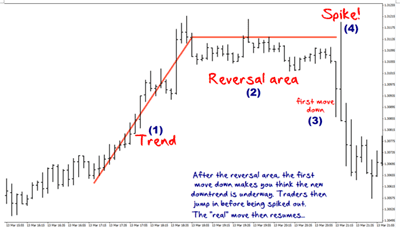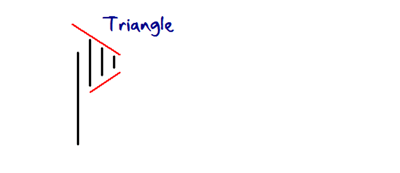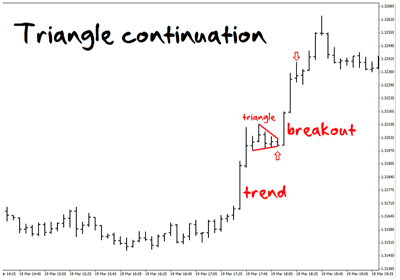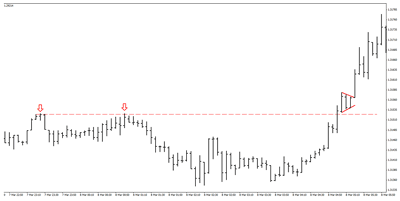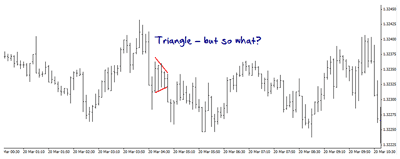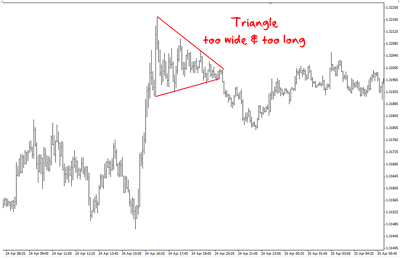Huzefa Hamid, co-founder of The Forex Room and contributor to DailyForex.com, explains how the triangle pattern can be used to trade short-term currency pairs.
Back in the 1990s, when Homer Simpson was still funny and new retail traders were first discovering technical analysis, there was a greater focus on price action alone without the use of indicators.
Traders divided up their analysis into three broad categories: trends, reversals, and continuation patterns. So a trader would try to determine what phase the market was in for their preferred time frame; i.e. “Is the market trending or is that a double-bottom that’s just formed and is the market now reversing?”
Every trader would love to simply buy into a new trend and just go with it, but finding the beginning of a trend in real time just after the market has finished reversing can be tricky. Price action around a reversal is often spiky and volatile, so even if you are correct in identifying the beginning of a new trend, you can get stopped out of a trade because the reversal hasn’t quite finished. Annoyingly, the price frequently spikes the other way just before moving in the predicted direction of the new trend.
The above EUR/USD (5 min) chart is a classic example of a reversal spike. The price trends up (1); it then moves sideways and quickly looks like it’s forming a reversal pattern as prices above get rejected and a resistance forms (2). Traders are now anticipating a downtrend.
Then, as expected, it makes a first move down breaking support (3). Many traders are now convinced that the new downtrend is in effect and jump in to go short. However, the price quickly spikes in the other direction and stops many of them out (4). The “real” down move down then begins.
So even though you would have been correct that a downtrend is about to form after the reversal, there’s a good chance you’d have been stopped out while trying to catch it.
In essence, if the price breaks out rapidly, you may get lucky by jumping in, or you may get very unlucky and have the price reverse on you the second you jump in. You need a logical point of entry.
That logical point of entry is the key reason to look at a continuation pattern…but which continuation pattern? As you may have guessed from the title of this piece, the triangle. Let’s look at how a triangle continuation pattern works.
A triangle pattern looks like its name and forms when the price bars (or candles) converge to a point:
NEXT: Real Trading Example Shows Pattern in Action
|pagebreak|Let’s look at a real example of a trade I took on the EUR/USD (5 min) chart to show how triangles are profitable:
After some sideways action, the price breaks out to form a new uptrend. So the market has shown its hand and you know there’s bullish momentum. But simply entering on the back of a rapid breakout is risky. This is where the triangle is much more profitable and safe.
See also: Forex Strategies: The Breakout Trade
Shortly after the breakout, some selling pressure comes in. This could be quick profit taking by buyers or other market participants wanting to go short. However, in this case the selling pressure can only gently pause the momentum and that pressure quickly dies down. This is the reason the triangle shape is formed. If the selling pressure was more substantial, you would see a proper pullback, and if it remained strong, you wouldn’t see the bars reduce in size (and hence converge into a triangle).
So what can you then deduce from this logic? Given the bullish momentum, you would expect it to continue up. So my entry was in the triangle (the first red arrow) and I exited shortly after at the second downward-pointing arrow. (The trade netted me 42 pips for an 8-pip stop and lasted under 20 minutes.)
Where do you place your stop loss? Just below the triangle. It’s that simple. This will almost always result in a tighter stop than if you buy on an initial breakout and place your stop below the previous support.
NOTE: If you pick up a standard technical analysis book, it will teach you to enter on the breakout of the triangle. For me, that’s too late. If you enter in the triangle, you can quickly move your stop to breakeven if the price does break out in your favor. Then, if that initial breakout from the triangle turns around, you will come out better. Plus, your stop will be tighter when entering in the triangle, thereby improving your risk/reward.
In the following example, a triangle identified a true breakout from a resistance level. Because the triangle broke out and rested nicely above the previous resistance, it showed me that the breakout was not a false one or a stop hunt; otherwise, the price would have quickly reversed. This triangle provided another clean entry.
NEXT: Signs of a Valid Triangle Pattern
|pagebreak|What Makes a Good Triangle Pattern?
A triangle continuation only means something when it is continuing something of relevance: if you see a triangle in the middle of a range, or in price action that you consider random or directionless, then it’s not a reason to get into a trade. Remember, the trend or breakout is the reason you want to get in; the triangle simply provides the point of entry.
For example, this triangle has no relevance in the context of the overall price action:
A triangle should just be a pause in the trend. The price may make a triangle shape, but if it is wide relative to the previous trend or goes on for too long, it’s not a “triangle continuation.” In fact, it is showing that the market is having a major rethink about the sentiment of the previous trend.
That is the heart of technical analysis. Always ask yourself, “What is price action telling you about the market participants’ emotions and sentiments towards the market?”) A good triangle continuation is tight and brief; you’ll know it when you see it!
Here’s an example of a triangle that doesn’t fit the idea of a brief pause to continue the trend:
All the previous examples are EUR/USD five-minute charts. But the same principles apply across different time frames. I have taken triangle trades off hourly charts and on one occasion off a daily S&P futures chart.
In summary:
1. You have a trend or a breakout and you want to find a safe entry
2. A triangle forms
3. Enter in the triangle and place your stop just below the triangle
4. Ride the breakout from the triangle to a pre-specified target or exit early if the price starts stalling
5. Manage the trade and move your stop to breakeven at a suitable time
By Huzefa Hamid, co-founder of The Forex Room, contributor to DailyForex.com
To learn more about trading continuation patterns, read “No Need to Pick Bottoms or Tops.”

